You are here: CBM Wiki>Public Web>PublicRich (2008-01-21, ClaudiaHoehne)Edit Attach
The Ring Imaging Cherenkov Detector (RICH)
Table of ContentsCherenkov Strahlung und RICH Detektor
Hier finden Sie eine allgemeine Einfuehrung in die Grundlagen der Cherenkov Strahlung und ihre Nutzung in RICH Detektoren.RICH detector concept
The RICH detector will serve for electron identification from lowest momenta up to 10-12 GeV/c needed for the study of the dielectronic decay channel of vector mesons. In the current CBM detector layout the RICH would be positioned behind the magnet with the silicon tracking system (STS/MVD) and in front of the first transition radiation detector (TRD), see the figure below for a sketch: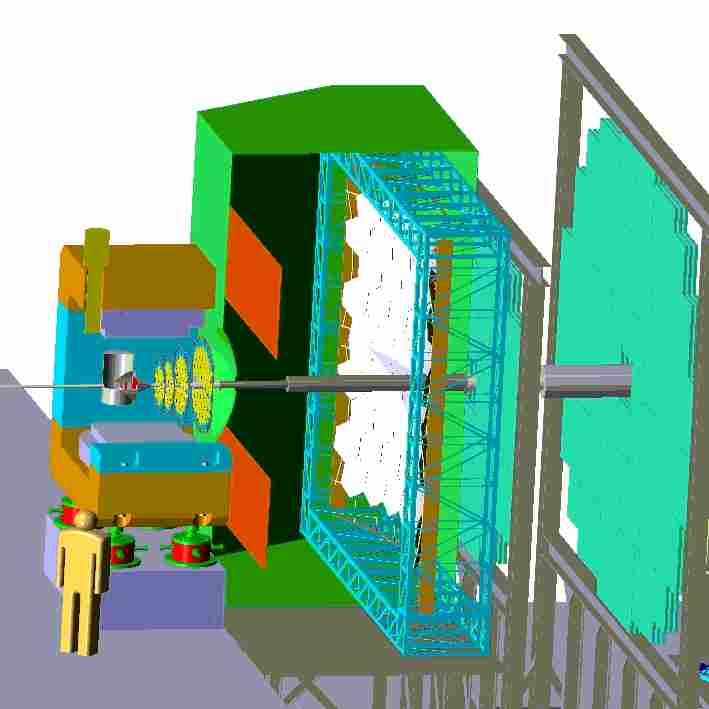
- gaseous RICH detector with vertically separated mirrors (R=450 cm), gas vessel (~ (6-7)m x 5m x 3m))
- radiator: N
 (if needed with admixture of CO
(if needed with admixture of CO for suppression of fluorescent light)
for suppression of fluorescent light)
- mirror: glass or carbon substrate, Al+MgF
 coating, surface ~ (5-6)m x 4m
coating, surface ~ (5-6)m x 4m
- photodetector (shielded by magnet yoke, granularity ~6mm x 6mm): preferable PMTs
Radiator
As introduced above, the Ring Imaging Cherenkov detector (RICH) is designed to provide electron identification in the momentum range of electrons from low-mass vector-meson decays, i.e. from lowest momenta up to 10-12 GeV/c. These requirements define possible gaseous radiators for the RICH detector; in addition it would be preferable if the gas is easy to handle, chemically passive and inflammable: Assuming that pions can be separated from electrons up to 90% of the maximum Cherenkov opening angle (
( ), the
momentum range for
), the
momentum range for  identification is illustrated in the figure below
in dependence on the Lorentz factor
identification is illustrated in the figure below
in dependence on the Lorentz factor
 , where n is the
refractive index of the medium. A radiator with %$\gamma_{\rm
th}>38$% would be ideal, because then the Cherenkov angle of pions
is less than 90% of
, where n is the
refractive index of the medium. A radiator with %$\gamma_{\rm
th}>38$% would be ideal, because then the Cherenkov angle of pions
is less than 90% of  for all momenta smaller than
12 GeV/c.
for all momenta smaller than
12 GeV/c.
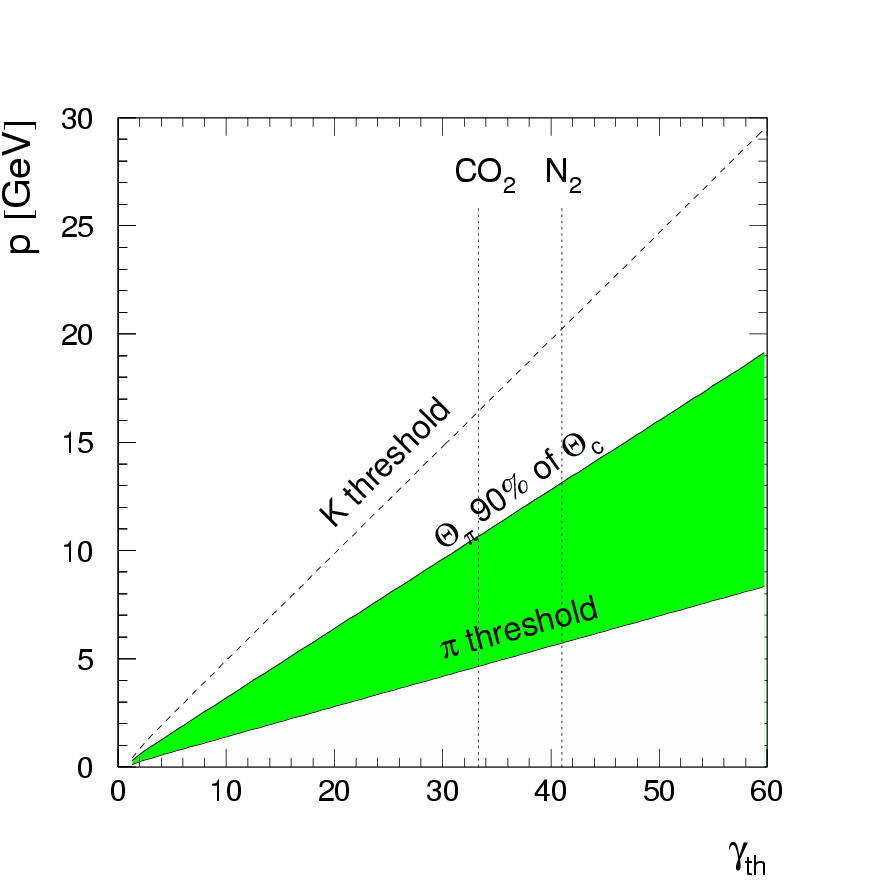
 . Also shown is the momentum at which the opening angle of pions corresponds to 90% of the opening angle of electrons. The green band thus indicates the approximate region of pion identification in dependence on
. Also shown is the momentum at which the opening angle of pions corresponds to 90% of the opening angle of electrons. The green band thus indicates the approximate region of pion identification in dependence on  .
.  for CO
for CO and N
and N is indicated by the dashed lines.
Nitrogen would fulfill all requirements, but also CO
is indicated by the dashed lines.
Nitrogen would fulfill all requirements, but also CO can be of interest. Important characteristics are its chromatic dispersion and transmittance, see figures below. One concern of nitrogen might be its fluorescence which could be quenched by some addition of CO
can be of interest. Important characteristics are its chromatic dispersion and transmittance, see figures below. One concern of nitrogen might be its fluorescence which could be quenched by some addition of CO [H. Morii et al., Nucl. Instr. and Meth. A 526 (2004) 399]. As PMTs are foreseen as photodetector, a lower wavelength cutoff of 175-150nm is fine. Within this range also the ring resolution does not yet suffer from the chromatic dispersion.
[H. Morii et al., Nucl. Instr. and Meth. A 526 (2004) 399]. As PMTs are foreseen as photodetector, a lower wavelength cutoff of 175-150nm is fine. Within this range also the ring resolution does not yet suffer from the chromatic dispersion.
- chromatic dispersion from [Landolt Boernstein Series, 6th Edition, volume II/8] and [Ph.D. thesis of Annick Bideau-Mehu (1982)]
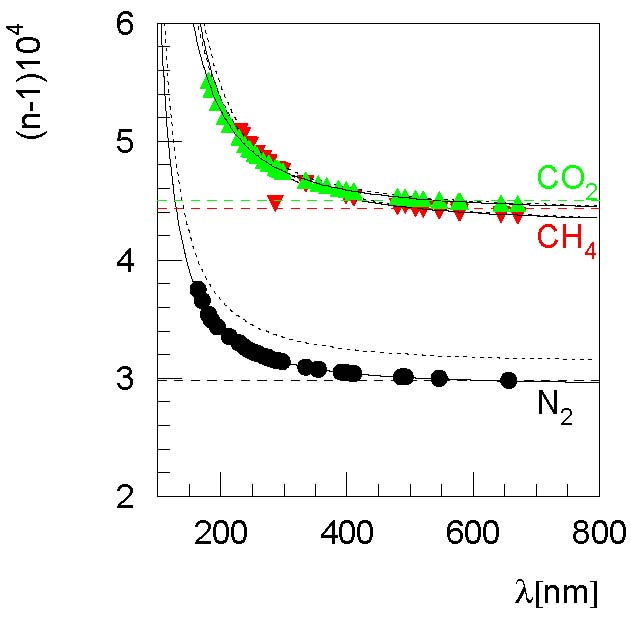
- transmittance of N
 from [Y. Tomkiewicz and E.L. Garwin, NIM V 114 (1974) 413]
from [Y. Tomkiewicz and E.L. Garwin, NIM V 114 (1974) 413]
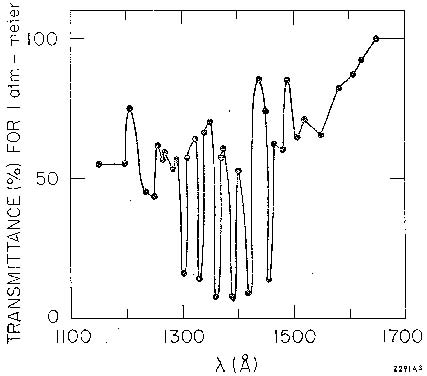
- absorption of water, O
 and CO
and CO from [Olav Ullaland, RICH04 workshop]
from [Olav Ullaland, RICH04 workshop]
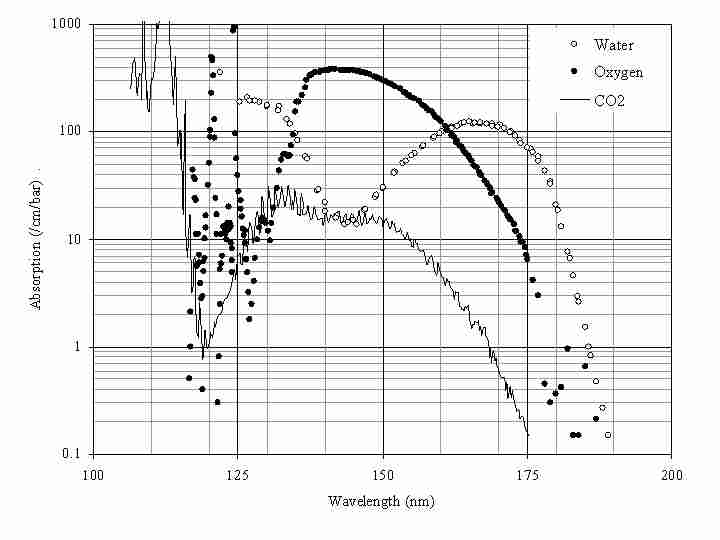
Mirror
The most important consideration concerning the mirror material will come from global tracking simulations: STS and TRD tracks have to be connected with high precision which limits length and material budget of the RICH detector. The maximum length will determine the radius of curvature. And as the mirror gives the largest contribution to the material budget of the RICH, the maxium allowable radiation length will determine whether glass mirrors can be used or a lightweight material such as carbon has to be used. Currently, we aim at glass mirrors of 3-4mm thickness and a diameter of 50-60cm. Mirrors based on carbon fibres are kept als alternative. The coating should provide highest reflection for the full range of photons not absorbed in the gas and detected by the photodetector, i.e. down to about 150nm. The choice will thus be a Al+MgF coating.
coating.
- reflection of Cherenkov photons in dependence on wavelength as measured by HADES [J.Friese et al, NIM A 502 (2003) 241]
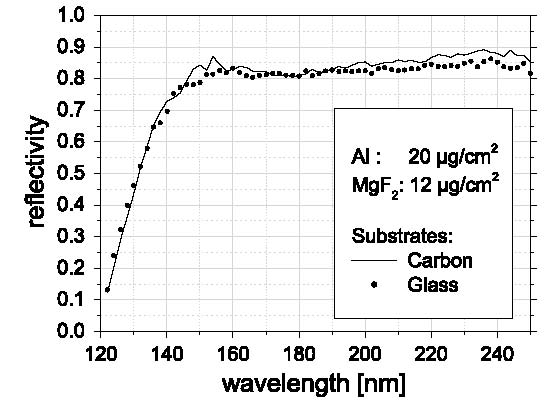
Photodetector
Highly granulated PMTs are foreseen as photodetectors. However, as the photodetector is the most important ingredient determining the final number of hits/ring, special care has to be taken to enhance the detection of photons from lower wavelengths. Basically two concepts are discussed currently:- development of small size PMTs (diameter ~6-7mm) by IHEP Protvino with bialkali photocathode, glass window and a wavelengthshifter film (p-terphenyl) to enhance the sensitivity in the near UV
- MAPMTs, e.g. from Hamamatsu (H8500) with pixel sizes of ~6mm x 6mm, bialkali photocathode and UV window to enhance the sensitivity in the near UV
RICH in simulations
The RICH detector is implemented in the CBM simulation framework (CBMroot) as introduced above:- gas vessel:
- entrance and exit window: 0.25mm kapton
- gas vessel: 5mm aluminum
- beam pipe: 0.5mm carbon
- Radiator: N2 with
- chromatic dispersion
- transmittance as presented in the above figures
- Mirror: 3mm glass substrate, radial curvature of 450cm and
- reflection properties as measured by HADES and presented above
- Photodetector: different options available, i.e.
- "Protvino PMT", diameter 8mm, hexagonal ordering, quantum efficiency enhanced in the UV region using wavelegnth shifter films attached to each glass window (proposal from Protvino, see e.g. Development of RICH, S. Sadovsky)
- multianode PMT from Hamamatsu H8500 with UV glass for enhanced UV sensitivity: 8x8 MAPMT with an effective pixel size of

- gas detector with CsI coated photocathode, see ALICE development (NIM A 502 (2003) 101): pixel size

- gas vessel: ~(6-7)m x 5m x 3m)
- mirror: 2 mirrors, vertically separated, full size of each ~ (5-6)m x 4m
- photodetector: 2 planes a 3.2m x 1.4m
| radiator |  |
beam energy | # rings | # rings (e) | # rings ( ) ) |
# rings (e, > 4 STS hits) |
|---|---|---|---|---|---|---|
| N2 | 41 | 15 GeV | 57.2 | 41.6 | 6.6 | 8.1 |
| N2 | 41 | 25 GeV | 91.3 | 63 | 19 | 14.1 |
| N2 | 41 | 35 GeV | 117.6 | 78.8 | 29.7 | 18.3 |
| CO2 | 33 | 25 GeV | 113.7 | 69.7 | 34.5 | 14.4 |
| photodetector | # channels | Nhits/ring (e) | geometrical coverage | double hits |
|---|---|---|---|---|
| Protvino PMT | 160k | 40 | 91% | ~12% |
| Hamamatsu | 214k | 22 | 85% | ~7% |
| CsI | 140k | 20.7 | 99% | ~13% |
Ring radius resolution
First estimates on the ring radius resolution which is important for e- separation at higher momenta indicate that 2-3% should be within reach. This would result in a 3
separation at higher momenta indicate that 2-3% should be within reach. This would result in a 3 separation of electrons and pions up to momenta of 13.5 GeV/c. In the following table extimates of the Cherenkov opening angle resolution for single photons are summarized for the main sources:
separation of electrons and pions up to momenta of 13.5 GeV/c. In the following table extimates of the Cherenkov opening angle resolution for single photons are summarized for the main sources:
| source |  [mrad] [mrad] |
|---|---|
| multiple scattering | ~1 (for p= 1 GeV/c) |
| magnetic stray field | < 1 (for p= 1 GeV/c) |
| emission point | small because of corrections, optimization |
| angular deviation of mirror | < 1 |
| chromatic dispersion | > 1 (strongly dependent on  ) ) |
| pixel size | 1-2 |
 mrad =
mrad =  mrad = 0.36 ... 0.7 mrad.
The Cherenkov opening angle for electrons in a N2 radiator is
mrad = 0.36 ... 0.7 mrad.
The Cherenkov opening angle for electrons in a N2 radiator is  =24.4 mrad. The estimated resolution lies thus in a range of 2...3%.
=24.4 mrad. The estimated resolution lies thus in a range of 2...3%.
Electron identification
With current, still preliminary simulations including the full CBM detector setup, ring recognition algorithms, ring-track matching algorithms and certain ring selection cuts the following results are achieved using STS and RICH information alone (Status as of Jan. 2007):- Radius versus momentum for selected "good" rings, the lines show a
 band for electron identification:
band for electron identification:
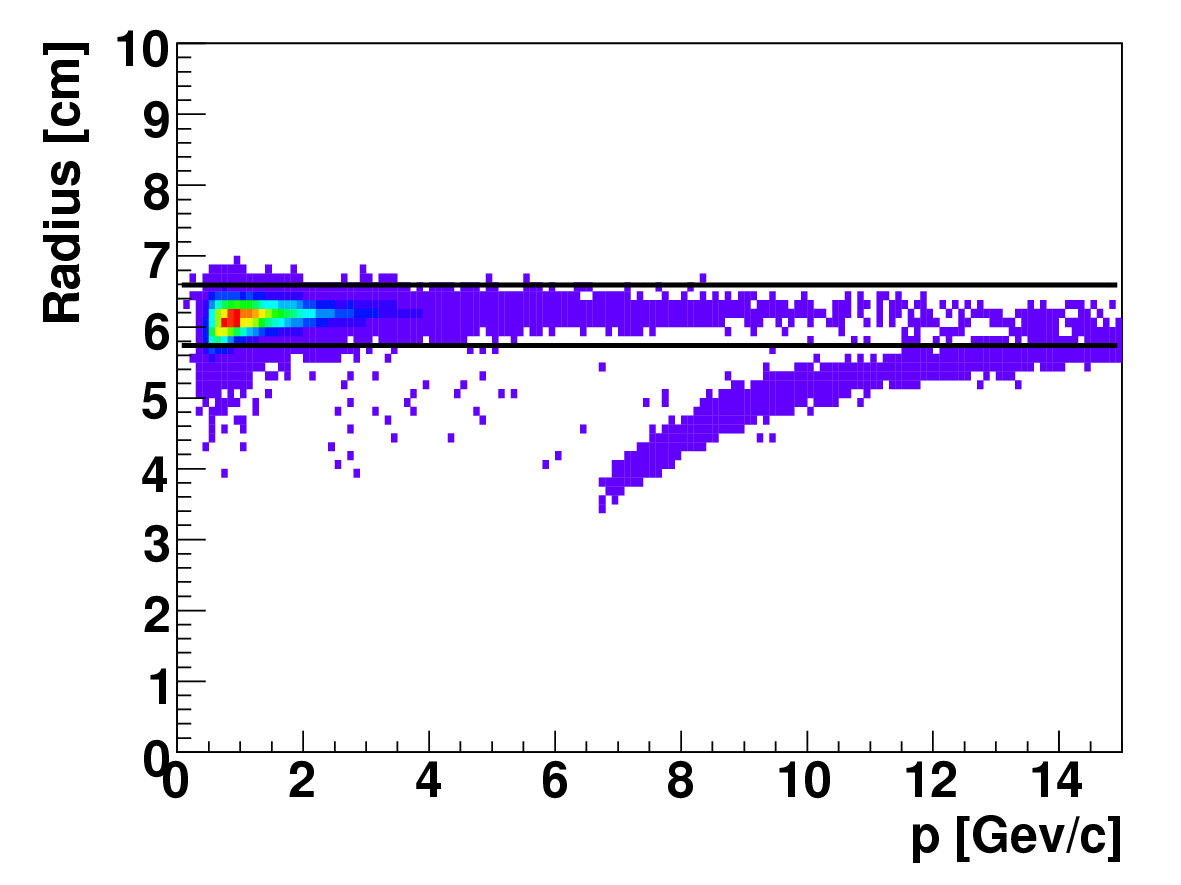
- Pion suppression factor = (
 id. as e)/(
id. as e)/( in RICH (or RICH & TRD) acceptance)
in RICH (or RICH & TRD) acceptance)
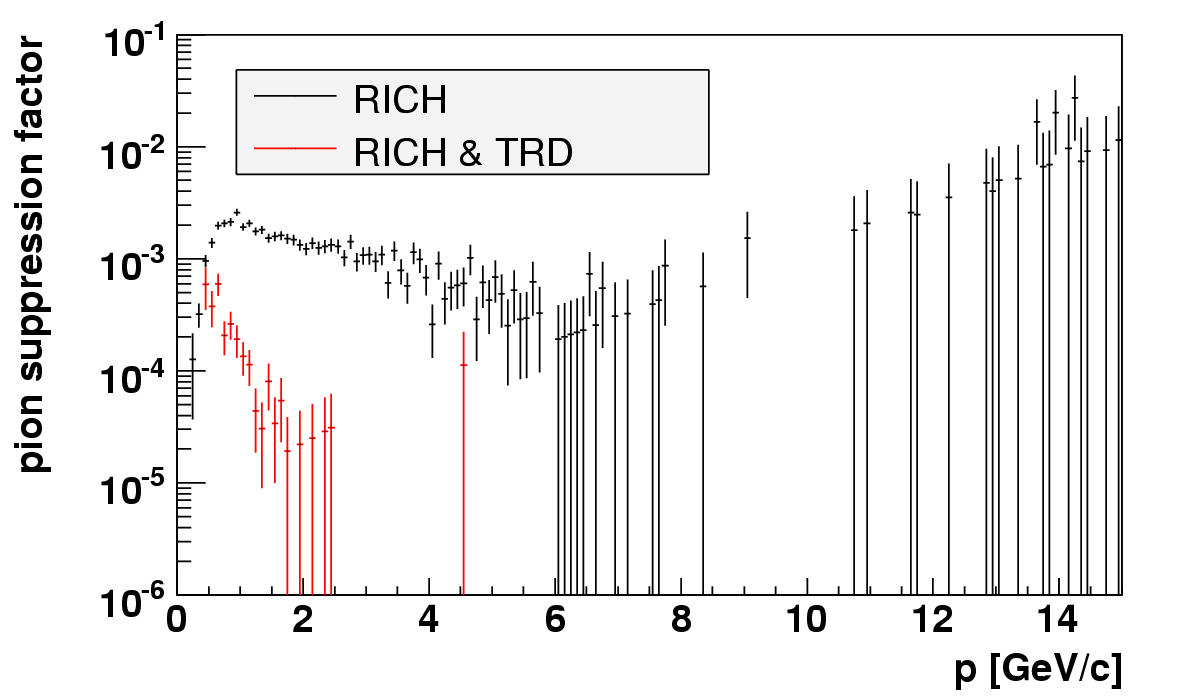
 in the above plot. Up to 10 GeV/c the main source of misidentification is matching of primary vertex pions to rings from secondary electrons which themselves have no reconstructed track. From 10 GeV/c on pions start to contribute in the sample which are identified as electron because their ring radius falls into the electron cut. Both sources can be reduced by additionally using in particular information from the TRD detector.
in the above plot. Up to 10 GeV/c the main source of misidentification is matching of primary vertex pions to rings from secondary electrons which themselves have no reconstructed track. From 10 GeV/c on pions start to contribute in the sample which are identified as electron because their ring radius falls into the electron cut. Both sources can be reduced by additionally using in particular information from the TRD detector.
Presentations
- X International Workshop on Advanced Computing and Analysis Techniques in Physics Research (ACAT 2005) Elastic net for standalone RICH ring finding, S. Gorbunov
- DPG Spring Meeting, 2005 Concept for a RICH detector for the CBM experiment at the future accelerator FAIR facility at GSI in Darmstadt, C. Hoehne
- 5th International workshop on Ring Imaging Cherenkov detectors (RICH 2004) Concept for a RICH detector for the CBM experiment at the future accelerator FAIR facility at GSI in Darmstadt, C. Hoehne
RICH workgroup pages (login required)
Internal pages: Follow this linkEdit | Attach | Print version | History: r11 < r10 < r9 < r8 | Backlinks | View wiki text | Edit wiki text | More topic actions
Topic revision: r11 - 2008-01-21, ClaudiaHoehne
 Copyright © by the contributing authors. All material on this collaboration platform is the property of the contributing authors.
Copyright © by the contributing authors. All material on this collaboration platform is the property of the contributing authors. Ideas, requests, problems regarding CBM Wiki? Send feedback
Imprint (in German)
Privacy Policy (in German)

